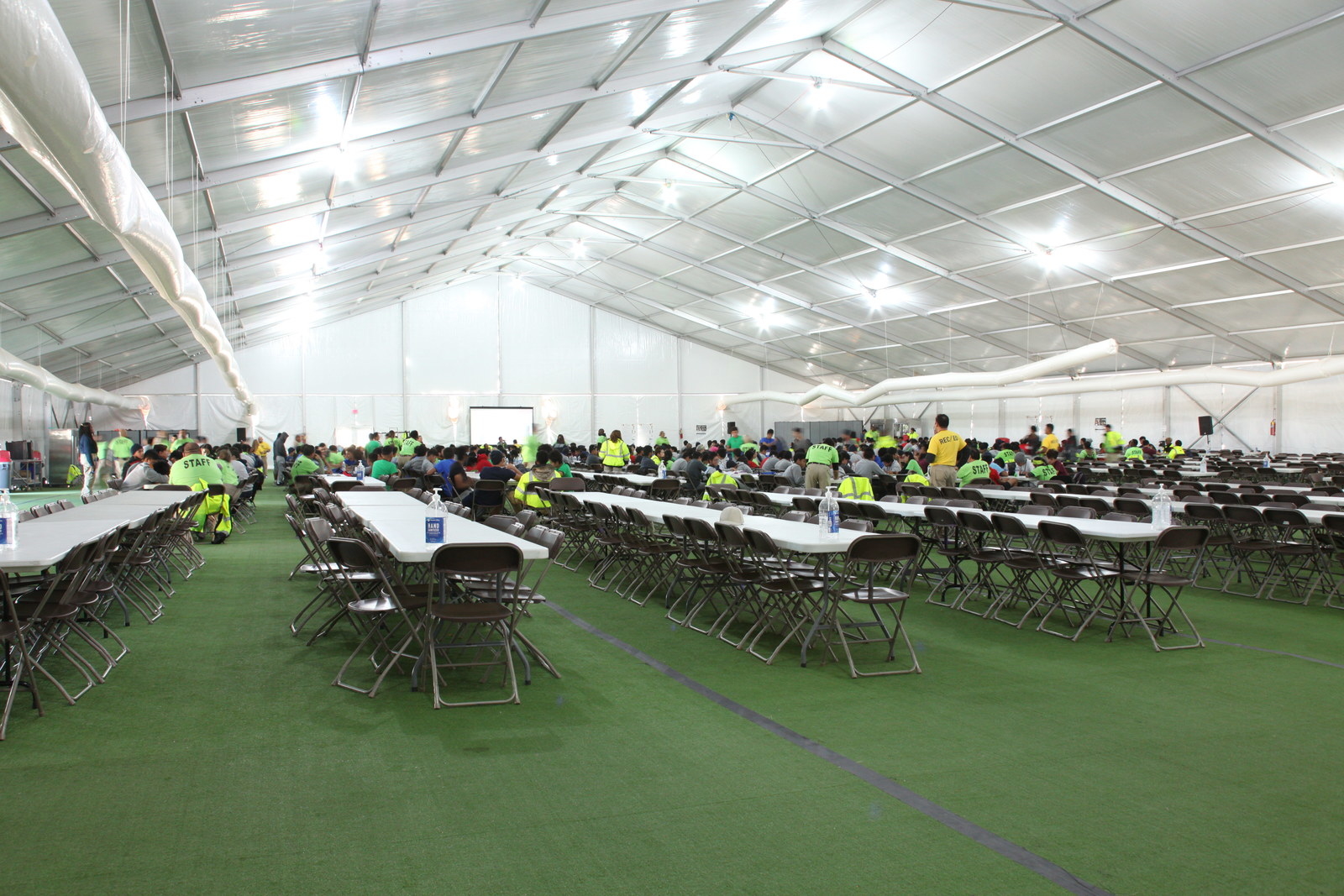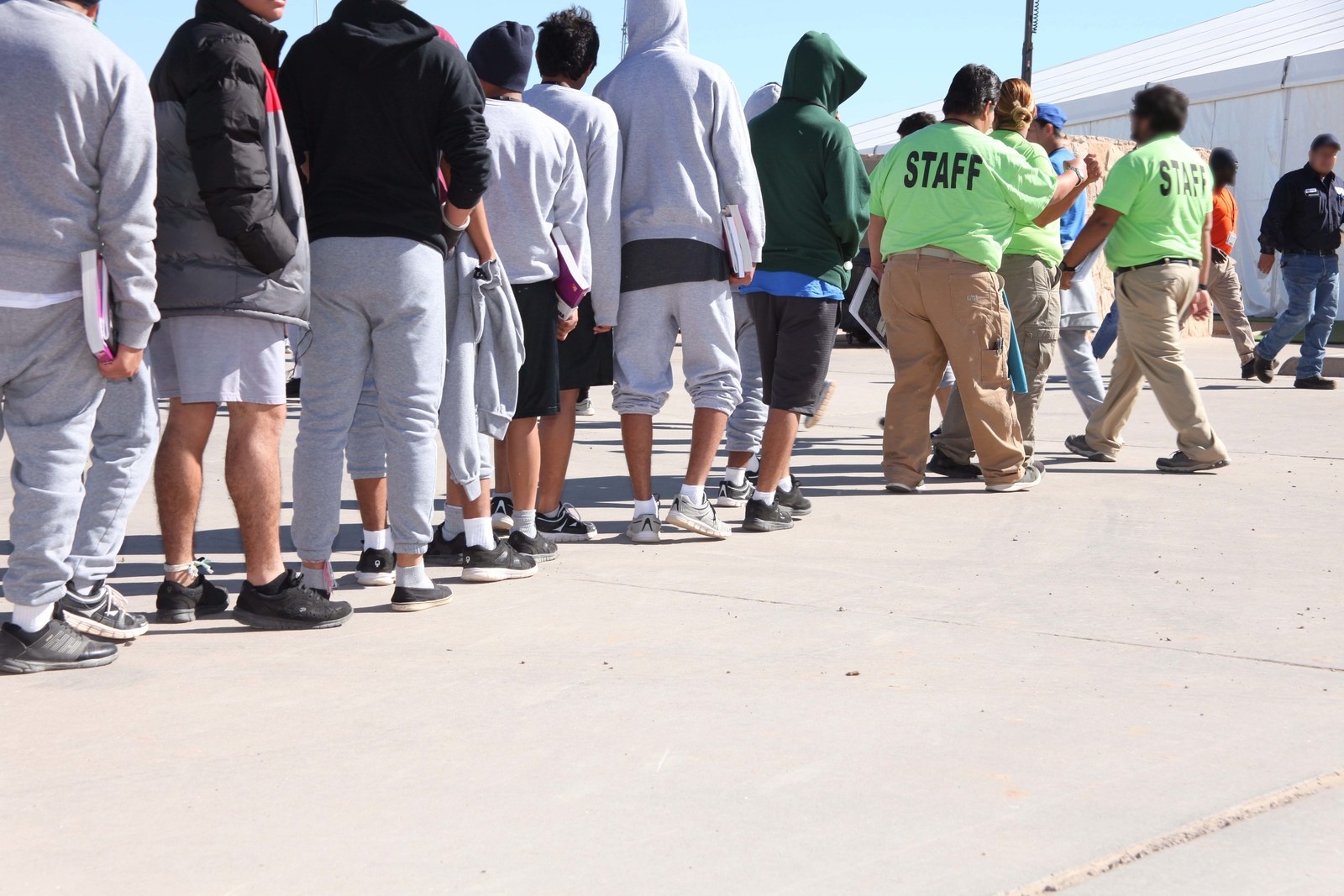
A Brief Audio Tour of the Arlington Immigration Court
A Brief Audio Tour of the Arlington Immigration Court
by
Judge Paul Wickham Schmidt
United States Immigration Judge (Retired)
Federal Bar Association & Tahirah Justice Center Pro Bono Training
Columbus School of Law
Catholic University of America
Washington, DC.
Oct. 26, 2018
Thanks so much to our FBA Immigration Section Chair Betty Stevens, Danielle Beach-Oswald, and Kursten Phelps of The Tahirih Justice Center for putting this great program together and inviting me. It’s always an honor to be on a panel with my good friend Professor Maureen Sweeney the Director of the Immigration Clinic at UMD Baltimore. Unlike me, (I’m just an “interested observer” at this point) Professor Sweeney and her clinic students “walk the walk and talk the talk” in Immigration Court all the time. So, please direct all of your questions to Professor Sweeney.
I call this speech “A Brief Audio Tour of the Arlington Immigration Court.” It gives you a very compact introduction to what happens in Immigration Court, namely the U.S. Immigration Court in Arlington, Virginia.
Our tour today consists of two parts, both concentrating on asylum cases, since those are a significant part of the docket and the topic of this training. First, I will give you an overview of the Arlington Immigration Court, as much of it as I still understand as an “outsider” who was once an “insider.” Second, I will describe the mechanics of an asylum case in Immigration Court. When I am done, you should have at least some idea of what happens at the “retail level” of our immigration system.
As some of you know, I used to give a comprehensive disclaimer. But, I’m retired now, so I don‘t have to do that. But, I do want to hold the FBA, The Tahirih Justice Center, Catholic University, Professor Sweeney and everyone else concerned harmless for my remarks today which are my opinion and mine only. No sugar-coating, no bureaucratic doublespeak, no “party line,” no BS – just the unvarnished truth, as I see it!
As your tour guide, and because this is Friday, and you are such a great audience, I also give you my absolute, unconditional, money-back guarantee that this tour will be completely free from computer-generated slides, power points, or any other type of distracting modern technology that might interfere with your total comprehension or listening enjoyment. In other words, I am the “power point” of this presentation
I. Immigration Court Overview
For those of you unfamiliar with the Immigration Court system, while it’s called a court, and sort of looks like a court, it’s actually a dysfunctional mess that has little resemblance to any other real court system in America! Your challenge will be to figure out how to get a broken system to work well enough to provide justice for your client in your particular case. The good news: It can be done!
And, I will say that your chances of doing that in Arlington and Baltimore, where the judges have a history and a reputation of treating all parties fairly, impartially, professionally, and courteously will be better than in many other courts.
The Arlington Immigration Court is part of the Executive Office for Immigration Review — affectionately known as “EOIR” for you Winnie the Pooh fans — a separate branch of the U.S. Department of Justice. There are approximately 350 Immigration Judges in more than 50 court locations nationwide, with another 100 or so additional judges “on order.”
As an Immigration Judge, I was an administrative judge appointed by the Attorney General. I was not a judge under Article III of the Constitution, like a U.S. District Judge, who is appointed for life by the President and confirmed by the Senate. My powers and authority were delegated by the Attorney General and limited by his or her regulations.
Unfortunately, that means that the Immigration Judges currently work for Jeff Sessions. He is an unapologetic immigration restricitonist and enthusiastic cheerleader for DHS immigration enforcement. He has expressed great antipathy for asylum seekers and their attorneys – namely you! His actions have stripped Immigration Judges of effective control over their dockets and made it much more difficult for refugees from Central American, particularly women, to obtain protection which they desperately need and richly deserve under our laws as properly interpreted and applied.
One of the best descriptions of what it’s like to be an Immigration Judge was offered by the late Judge Terence T. Evans of the Seventh Circuit Court of Appeals who said:
Because 100 percent of asylum petitioners want to stay in this country, but less than 100 percent are entitled to asylum, an immigration judge must be alert to the fact that some petitioners will embellish their claims to increase their chances of success. On the other hand, an immigration judge must be sensitive to the suffering and fears of petitioners who are genuinely entitled to asylum in this country. A healthy balance of sympathy and skepticism is a job requirement for a good immigration judge. Attaining that balance is what makes the job of an immigration judge, in my view, excruciatingly difficult.
Unfortunately, the need for balance and some sympathy for the situation of asylum seekers has been completely subsumed by this Administration’s fixation with deporting more migrants – at any cost. Indeed, in a recent outrageously inappropriate and unethical speech to newly hired Immigration Judges, Sessions actually told them “not to act out of a sense of sympathy for the personal circumstances of the respondent.” What a crock! Interpreting a humanitarian relief statute without humanity and empathy – it’s the polar opposite of “good judging” as described by the late Judge Evans!
My good friend and colleague, Judge Dana Leigh Marks, the President of the National Association of Immigration Judges, told the New York Times that “immigration judges often feel asylum hearings are ‘like holding death penalty cases in traffic court.’” I viewed my job as an Immigration Judge as half scholar, half performing artist.
Currently, there are 13 judges sitting at the Arlington Immigration Court. While at one time, all the judges were “generalists,” handling all types of cases, that had started to change even before my retirement in June 2016. For example, Judge Bryant was assigned full time to the juvenile dockets, while other of my colleagues worked full time on detained cased, and others of us did only the non-detained docket.
I clearly recognize the hazards of peppering you with statistics, particularly on the first presentation of the morning. Nevertheless, I am going to throw out a few numbers just to give you some perspective on our workload. We must keep in mind, however, that these figures and percentages represent real people, with very human stories, encompassing all of the hopes, dreams, schemes, flaws, tragedies, and triumphs of mankind.
According to data from the Transactional Records Access Clearinghouse (known as “TRAC”), as of August 2018, there were nearly 43,000 pending cases at the Arlington Immigration Court, of which approximately 500 were on the detained docket. The average pending docket, therefore, is approximately 3,000+ cases per judge, giving rise to an average wait of 830 days – more than two years – for a case to be decided, and leading to a mushrooming nationwide backlog in excess of 750,000, notwithstanding additional judges on the bench.
This Administration’s misguided policies and mismanagement are rapidly destroying the U.S. Immigration Court System as we speak. Typically, Sessions tries to shift the blame elsewhere – primarily to the victims: you and your clients and the demoralized U.S. Immigration Judges caught up in this nightmare parody of a court system.
At one time, each Arlington Judge had a detained and a non-detained docket, and each of those was subdivided into Master Calendar and Individual Calendar dockets. The majority of the time was spent on the non-detained docket. In Arlington, detained cases are heard exclusively by TeleVideo connections, mostly with the DHS Contract Detention Center in Farmville, and sometimes with various regional jails in Virginia. Farmville is conveniently located in in the rural southern part of the state, far away from Arlington or any other major metropolitan area.
At one time, there were case priorities in the Immigration Courts. However, my understanding is that those have been abolished except for detained cases. Apparently, all non-detained cases are now of equal priority, meaning that none are priorities. This leads to a phenomenon I’m sure you will experience that I call “Aimless Docket Reshuffling” or “ADR.” Cases are arbitrarily and inexplicably moved around the judges’ dockets at the whim of the politicos at the DOJ and their subordinates at Falls Church.
Each judge conducts at least one Master Calendar, sometimes more, per week. The Master Calendar is basically the court’s intake and triage system, similar to an arraignment or preliminary hearing in the criminal court system.
The most important aspects of a Master Calendar are finding out the type of case, taking pleadings, ascertaining interpreter requirements, accepting applications for relief (including asylum), checking the status of fingerprints and biometrics, checking the address, giving warnings, ruling on preliminary motions, and, most important, ensuring that the alien, known as the “respondent” in our “Removal Proceedings” gets a lawyer, at no expense to the Government. If the respondent does not have a lawyer at the initial Master Calendar, the judge hands out the official list of free or low-cost legal service providers in the area and reset the case to another Master.
Of course, given the backlogs and ever shifting priorities, most free or nominal cost legal service providers are already overwhelmed and can’t take additional cases on the unrealistic schedules sometimes set by the courts at Sessions’s urging. This perverse system runs largely without regard to, and sometimes with intentional disregard of, the availability and professional needs of the hard-working, often pro bono or “low bono,” attorneys who are literally “keeping it afloat.” Indeed, I predict that at some point you will feel that you are the only ones honestly trying to make this system work. Otherwise, from top down, it’s largely “programmed for failure.”
Once the preliminaries have been satisfied during the Master Calendar process, the case is assigned a date for an Individual Calendar hearing. This is the hearing on the merits, which most often involves an application for relief from removal by the respondent. At the Individual hearing, the judge will admit evidence, listen to witnesses, hear arguments by both counsel and either render an oral decision on the merits or schedule a date for issuing a written decision.
The Arlington Immigration Court does a full range of cases. In addition to asylum-related matters, this includes custody and bond proceedings for individuals in detention, cancellation of removal for both residents and non-residents, contested issues of removability, returning permanent resident aliens, adjustment of status, and various types of waivers of grounds of removability, many of them related to criminal convictions. The judges also decide many motions, some of them dispositive, in chambers. Historically, the majority of Individual Calendar time in Arlington has been spent on asylum and related cases such as withholding of removal or relief under the Convention Against Torture (“CAT”).
Judges are under pressure to complete more cases and have been directed to schedule at least three, sometimes more, merits cases per day. Part of the system for pressuring judges involves new “performance quotas” that ultimately can be used in making retention decisions for the judges.
Remarkably, while EOIR hasn’t been able to produce a functioning nationwide e-filing system after nearly two decades of failed efforts (in which both Betty Stevens and I were involved during our Government careers, well over a decade ago), they miraculously have been able to produce the “Immigration Judge Automated Dashboard.” Thus, every Immigration Judge’s computer now has a “stress screen” that reminds them of how they are doing on their “quotas” and “time limits.”
It’s all a question of priorities! Sadly, at the “New EOIR,” public service and Due Process take a back seat to the restrictionists’ political agendas.
Asylum cases reach Immigration Court in two basic ways. One is through “affirmative applications” filed initially at the Department of Homeland Security (“DHS”) Asylum Office in Arlington and “referred” to the Immigration Court for a de novo, that is, “entirely new,” hearing if that office is unable to grant. The other way is by “defensive applications” filed initially with the Immigration Court after a Notice to Appear has been issued.
During most of my career at Arlington, the number of affirmative filings exceeded defensive filings. However, according to EOIR statistics, in recent years there has been a dramatic reversal so that defensive applications now greatly exceed affirmative applications by a ratio of approximately 16:1 in FY 2016. Perhaps not surprisingly, affirmative application grant rates are substantially greater than those for defensive filings.
According to the latest TRAC reports, for the period 2012-2017, for one representative Immigration Judge in Arlington approximately 25% of the asylum cases were from Ethiopia, followed by El Salvador (16%), PRC (13%), Cameroon (5%), and Eritrea (5%). According to media reports and U.S. Department of State Country Reports, none of these countries is exactly a “garden spot” with respect to human rights and, with the exception of China, none would be major tourist destinations. In fact, according to EOIR statistics, China, Ethiopia, and Eritrea have been among the “top ten” asylum grant countries for many years, with China leading the pack.
The Immigration Court nationwide asylum grant rate has been falling steadily since the “high-water mark” of nearly 56% approvals in FY 2012. It was 43% in FY 2016. Still, in that year the grant rate for Arlington was 62%, well above the national average.
In Arlington, the attorney representation rate for asylum seekers historically has been at or above 90%. Nationwide, it was approximately 80% during FY 2017. Generally, representation rates are significantly lower for asylum seekers in detention.
II. MECHANICS OF AN ASYLUM CASE
Turning to the mechanics of an asylum case in Immigration Court, I will focus on the non-detained docket which historically has comprised the vast majority of cases at Arlington. You should be aware, however, that more and more asylum-related matters do appear on the detained docket, and are, therefore, given a higher priority than non-detained cases. This is likely to increase as Sessions appears to be on track to reverse the BIA precedent allowing bond for those who pass the credible fear process at the border.
A non-detained asylum case referred from the Asylum Office to the Arlington Immigration Court will be given an initial Master Calendar date a number of months in the future. In other words, a non-detained asylum case referred by the Arlington Asylum Office today might not appear on any Master Calendar until sometime next year.
In the past, all cases were randomly assigned to the Arlington Immigration Judges by the Court Administrator, who is analogous to the Chief Clerk of a state court, and our dedicated administrative staff. Each of us received an approximately equal number of new cases. I can’t tell you how they are assigned today. But, I assume there is at least some attempt to distribute the work equally among the judges.
In Arlington, a non-detained Master Calendar usually consists of 40-50 cases in a three-hour time slot. When the case initially appears on Master Calendar, one of two things usually happens. If the respondent has an attorney, the case usually will be set for the next available Individual Calendar hearing, often several years in the future for non-detained cases. Alternatively, a respondent who does not have an attorney will receive the Legal Services List, and the case will be reset for the next available Master Calendar.
Many cases “drop out” during the Master calendar process either when the respondent, having no relief from removal, accepts pre-merits-hearing voluntary departure or when the respondent fails to appear and therefore receives an in absentia removal order.
Additionally, the DHS, which initiates cases before the Immigration Court by issuing a “charging document” known as a “Notice to Appear,” (“NTA”) occasionally is unable to submit sufficient proof of the charge of removability at the Master Calendar hearing. This results in the dismissal or “termination” of the case, without prejudice to later refiling.
In the past cases, were terminated or continued to allow the respondent to apply for status to the United States Citizenship and Immigration Services (“USCIS”), a branch of the DHS. But, this practice has been severely restricted by recent precedents issued by Attorney General Sessions. The judge can also grant a change of venue (“COV”) to another Immigration Court if the respondent no longer lives within the jurisdiction. The most common COVs in this area are Arlington to Baltimore and vice versa.
Obviously, the Immigration Court has no jurisdiction over U.S. citizens. Therefore, nationality, or alienage, is an important jurisdictional issue. While alienage is usually conceded by the respondent during the Master Calendar process, occasionally merits hearings involving complex questions of U.S. citizenship. This is certainly an important issue that an advocate must always fully explore fully before conceding alienage.
Otherwise, once the preliminaries have been satisfied during the Master Calendar process, the case is assigned a date for an Individual Calendar hearing. This is the hearing on the merits, which most often involves an application for relief from removal by the respondent. As mentioned earlier, at the Individual hearing, the judge will admit evidence, listen to witnesses, hear arguments by both counsel and either render an oral decision on the merits or schedule a date for issuing a written decision.
Not surprisingly, unrepresented asylum cases, those where the respondent cannot find a lawyer and tries to represent him or herself, seldom are happy experiences for anyone involved. Fortunately, as I mentioned earlier, most asylum applicants in Arlington, at least on the non-detained docket, are represented.
Some of the representation, particularly that coming from dedicated and scholarly lawyers, law school clinics, and large law firms appearing pro bono, is truly outstanding. In the case of large law firms and clinics, this might be because those organizations are likely to be willing and able to devote the time, resources, and attention to detail that complex asylum cases require. For example, 20 years ago when I was a partner at a major American law firm we generally budgeted 100 hours of attorney time for a pro bono immigration hearing and 40 hours for any appeal.
Over the years, the Arlington Immigration Court has provided educational outreach and “hands on” practical training opportunities to countless law students, new attorneys, and interested observers from both the private and public sectors.
When I became an Immigration Judge in 2003, fully contested asylum hearings were the norm at the Arlington Immigration Court. Over time, thanks to the joint efforts of the DHS Chief Counsel for Arlington and the local bar, there were many fewer fully contested asylum hearings than in the past. In many cases, particularly those involving natives of countries we saw on a repetitive basis, key issues or eligibility were stipulated, that is, agreed upon by the parties, thus allowing the judges to concentrate on genuinely disputed points or cases.
Additionally, under the Obama Administration policies, the Office of Chief counsel often offered “prosecutorial discretion” or “PD” to individuals with good behavior and substantial equities in the U.S.
However, the Trump Administration has dramatically curtailed the PD program by DHS, while Sessions has removed the authority of Immigration Judges to “administratively close” cases, thus removing them from the docket. Combined with the negative asylum precedents issued by Sessions, and the overwhelming emphasis on enforcement, you should expect that almost all asylum cases will be fully contested by DHS Counsel. In all too many ways, the Immigration Court system is actually regressing in terms of fairness and efficiency as a result of the Trump Administration’s approach to immigration enforcement.
An average contested non-detained asylum hearing before me took approximately three to four hours. That often generated an appellate transcript well in excess of 100 pages. Although not always obvious from the hearing transcript, the hearing time and stress levels substantially increase if we are using a foreign language interpreter, which happens in the majority of asylum cases.
Generally, preliminaries such as marking the record, discussing any evidentiary objections, and opening arguments took approximately 30 minutes. The Assistant Chief Counsel for the DHS, the prosecutor, fulfills a role similar to that of an Assistant Commonwealth’s Attorney or an Assistant District Attorney in the state criminal justice system, or an Assistant U.S. Attorney in the federal system. The Assistant Chief Counsel usually submits the latest State Department Country Report and other relevant Department of State reports, such as the International Religious Freedom Report, if not submitted by the respondent. This insures that the record reflects the social, political, religious, and historical context in which the persecution claim is made.
I expected opening statements from both counsel identifying and discussing the issues. But, not all Immigration Judges encourage or even permit opening statements. It’s always wise to ascertain the judge’s preferences in advance.
As you can imagine, the primary issue in most asylum hearings is credibility, that is, whether the respondent’s version of what happened or will happen in his or her home country appears to be reliable and true. The efficiency and accuracy of the Immigration Court system has improved markedly with the installation of a Digital Audio Recording system (known as the “DAR”) in each courtroom that replaced totally antiquated and all too often defunct tape recorders.
Usually, the respondent’s direct testimony took approximately one hour with the same amount of time for cross-examination by the Assistant Chief Counsel. In a substantial majority of the cases coming before me, I utilized the services of an EOIR-approved court interpreter. The most frequent foreign languages in my cases are Amharic (the native language of Ethiopia), Spanish, French (as spoken in many West African countries), and Mandarin Chinese. Predictably, as I mentioned earlier, having the hearing in a foreign language both takes considerably longer and increases the stress level in the courtroom.
Most respondents in asylum cases bring one or more corroborating witnesses, although sometimes the corroborating testimony can be summarized and accepted as a proffer. Expert witnesses, normally on country conditions, are not common, but occasionally appear for the respondent. Also, the respondent might present testimony from medical professionals with experience in working with survivors of trauma and/or torture. The judge might also receive notes or materials from the DHS Asylum Office.
For me, probably the most important part of the case was closing argument by both parties. But, not all judges have the same view. Also, as the pressure to produce more cases ramps up, and numerical quotas kick in, some judges will undoubtedly be looking for ways to cut corners and shorten hearings. Strange as it might seem if this were a real court system, eliminating or truncating both opening and closing statements might be one of the ways in which judges under pressure to produce numbers, not justice, choose to cut corners to meet quotas.
I allowed approximately 30 minutes for closings, during which time I normally questioned both parties about their legal and factual positions. I also took this opportunity to test my preliminary theories about the case.
If my notes showed various inconsistencies, omissions, or discrepancies during the examination, I raised these to respondent’s counsel to see how he or she would explain them and what arguments can be advanced as to why they are not fatal to the respondent’s case. Conversely, I challenged the DHS to tell me how and under what authority particular discrepancies could be a basis for disbelieving all of the respondent’s testimony or why the unchallenged documentary or corroborating evidence does not rehabilitate the respondent’s claim.
Often, I could tie portions of the closing argument directly into the analytical portion of my decision. I think that appellate judges, whether at the Board of Immigration Appeals or the Fourth Circuit, also appreciate seeing a demonstrably close relationship between what happened at trial and the merits decision.
At the conclusion, if the Assistant Chief Counsel either announces that he or she is satisfied that the respondent qualifies for asylum or that a grant will not be appealed, provided that fingerprints have cleared, the judge can announce the decision on the spot in a brief oral statement memorialized in a summary form order. I suspect that this will be happening much less often under the current regime. However, if prints have not cleared, the case must be put over to a Master Calendar to check prints and issue the final decision.
If either party is likely to appeal, the judge must issue a detailed decision on the merits. Most of those decisions are rendered orally at the end of the case. Judges are being pressured to issue more contemporaneous oral decisions. These, in turn, are more likely to be problematic when they reach the Courts of Appeals. “Haste makes waste,” as my mother used to say.
If the case is very complex, the judge will take it under advisement and issue a detailed written decision. Often, that involves obtaining the assistance of one of the talented Judicial Law Clerks who serve at the court.
Because of the detail-oriented nature of credibility determinations, and the many legal requirements imposed by the statute, the Board of Immigration Appeals, and the Fourth Circuit, I found that the quality and fairness of my final decision was substantially improved by having someone listen to the recorded hearing and compare the testimony with the asylum application, documentation, and country background information in the record. However, as Sessions candidly admitted in a recent speech to Immigration Judges, the emphasis these days is strictly on volume, not quality or Due Process for respondents (ironically, the only reason for the system’s existence).
III. CONCLUSION
In summary, I have shared with you a snapshot of the Immigration Court system. I also have given you an overview of the Arlington Immigration Court and the way in which asylum cases move through our court system, in other words, “due process, or what passes for it these days, at the retail level.” I hope that I have increased your understanding of the Immigration Courts and inspired you to fight to restore balance, fairness, professionalism, and Due Process to this critically important part of our American justice system.
This concludes today’s “mini-tour.” Thank you for listening.
(11-01-18)
























